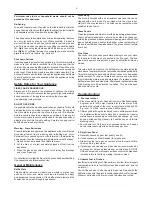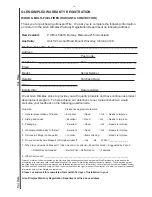
Petroleum coke fuels or household waste should not be
burned on this appliance.
De-Ashing
To de-ash the grate insert the notch on the riddle hand tool into the
peg on the side of the stove
(D - Fig 6)
, then draw the tool forwards
and backwards with a slow positive action
(Fig 7)
.
The ash pan should be emptied each time after operating the stove
so not to let build up of ash occur. Where possible, it is best to
wait until the stove and ash has cooled before removing the ash
pan. To remove, open the stove door by lifting the handle upward
(C - Fig 6
then using the riddle handle lift the ash pan out of the
fi
re
(Fig 8).
For ef
fi
cient burning of your appliance, make sure the
grate is clear of burnt debris; e.g. nails, etc.
Shut down Periods
If shutting down the stove for long periods (e.g. for summer months)
make sure that all ash is removed from the stove and that the
chimney
fl
ue ways and baf
fl
e plate are brushed clean. When the
stove is cold a vacuum cleaner may be used to remove any residual
ash or soot. Close the door and leave all air inlets open fully. This
action will ensure air circulation through the appliance and will help
to avoid corrosion and condensation within the appliance during
this shut down period.
Safety Notes for Your Guidance
FIRES CAN BE DANGEROUS.
Always use a
fi
re guard in the presence of children, the elderly
or the in
fi
rm. Inform all persons the dangers of high temperatures
during operation of the appliance including the stove pipe.
Use operating tools provided.
DO NOT OVER FIRE.
It is possible to
fi
re the stove beyond its design capacity. This could
damage the stove, so watch for signs of over
fi
ring. If any part of
the stove starts to glow red, the stove is in an over
fi
re situation
and the controls should be adjusted accordingly to reduce air
intake. Never leave the stove unattended for long periods without
adjusting the controls to a safe setting. Careful air supply control
should be exercised at all times.
Warning - Fume Emissions
Properly installed and operated, this appliance will not emit fumes.
Occasional fumes from de-ashing and refuelling may occur.
Persistent fume emission must not be tolerated. If fume emission
does persist, then the following immediate action must be taken:
1. Open doors and windows to ventilate the room.
2. Let the
fi
re out, or eject and safely dispose of fuel from the
appliance.
3. When the stove has cooled, check for chimney
fl
ue blockage
and clean if required.
Do not attempt to relight the
fi
re until the cause has been identi
fi
ed.
If necessary seek professional advice.
General Maintenance
Baffl e Plate
This should be removed at least once a month to prevent any
build up of soot or ash, which could lead to blocked
fl
ue ways
and dangerous fume emission. If the baf
fl
e plate is removed the
fl
ueway can be swept through the appliance.
Stove Body
The stove is
fi
nished with a heat resistant paint and this can be
cleaned with a soft brush. Do not clean while the stove is hot,
wait until it has cooled down. The
fi
nish can be renovated with a
suitable brand of paint.
Glass Panels
Clean the glass panels when cool with a proprietary glass cleaner.
Highly abrasive substances should be avoided as these can
scratch the glass and make subsequent cleaning more dif
fi
cult. Wet
logs on heated glass, a badly aimed poker or heavy slamming of
the doors could crack the glass panels. The glass will not fracture
from heat.
Flue Pipes
Check your
fl
ue pipe each year before starting to use your stove
for the winter. Birds may have nested in the
fl
ue cowl. The
fl
ue
pipe must be swept at least once a year by a Quali
fi
ed Chimney
Sweep.
To avoid a build up of soot on the baf
fl
e plate (the plate inside the
stove above the grate) it must be removed and cleaned periodically.
This plate locates the back and side
fi
rebricks so note its position
before removal. To remove, lift plate and remove one side brick;
this will allow the plate to drop and aid removal. To replace, position
baf
fl
e plate on back and side plate, lift plate and replace remaining
brick, making sure it has located in position. This must be done
when the stove is cold.
Troubleshooting
1. Poor heat output
a. Stove too small for room: Seek advice from a Quali
fi
ed Heating
Engineer as to (kW) output required for the room size. As a
guideline the volume of the room in cubic feet divided by 500;
e.g. room 15’x15’x8’ would require 3.6kW approx.
b. Chimney and/or
fl
ue pipe restricted, room ventilation restricted:
On installation these should have been checked but regular
maintenance is necessary as conditions can change; e.g. soot
build up, birds nesting, masonry fall, dust build up or furniture
blocking vents.
c. Poor quality fuel: Only burn dry seasoned timber, soft woods
have a lower heat output than hard woods per hour.
2. Dirty Glass Panel
a. Generally caused by poor fuel quality, see (1c)
b. Use secondary air slide (Airwash) for glass panel
c. Fire burning too low, open air vents on stove to create hot
fi
re;
this may ‘burn’ glass clean.
d. If glass requires cleaning use glass cleaner recommended by
your supplier; only use glass cleaner on cold glass. DO NOT
USE any abrasives or scrapers as these will scratch glass and
increase future tar build up making it harder to clean.
3. Unburnt Fuel in Firebox
Insuf
fi
cient air reaching fuel. Open primary air slide, this will supply
combustion air to burn fuel fully (unless it has reached a ‘point of
no return’)
Check if the ash pan is full and empty if required. De-ash with the
riddler to make sure the grate is not blocked and check for jammed
clinker or nails when the
fi
re is out and the stove has cooled.
- 5 -



































